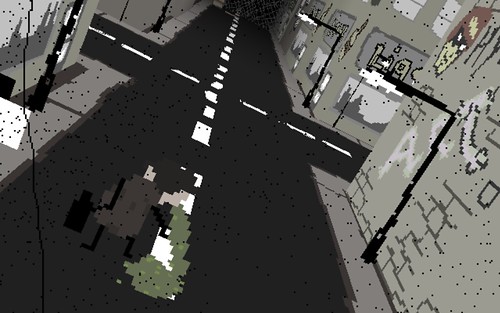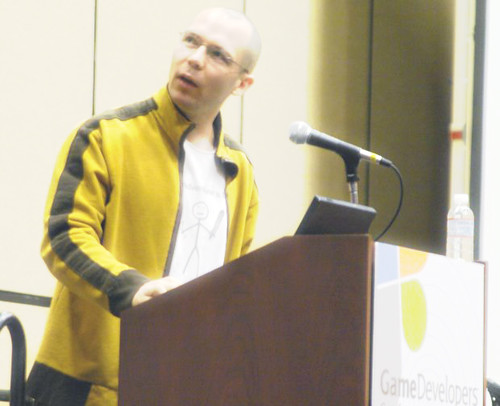Posts from ‘Games and Art?’ Category
Dust: An Elysian Tail – Trailer
By: Xander
On: August 6th, 2009
Dust is just one of a number of projects being created under the ‘Elysian Tail’ franchise, which includes an independent animated feature film and of course this very pretty game. Dean Dodrill is the man behind the animation, and the programming, and the sound and.. well everything except for the music.
There isn’t much to go on currently beyond this trailer, but it seems to divulge a fair amount of the gameplay, where the majority of the action is reminiscent of a side-scrolling beat’em up with a dash of platforming thrown in for good measure. So far it looks pretty damn exciting, with special note of course going towards the animation which just makes everthing look wonderful, even if you find the character designs a little offputting at first.
Definitely the biggest barrier the game will face will be trying to cross that strange ‘furry threshold’, as so long as the controls and hit-detection feel satisfying this could be the one of the best games to hit.. actually, what is it coming out on?
As it is being entered into the Dream Build Play competition it maybe a full Xbox Live Arcade title. If not though it may end up as an ‘Xbox Indie’ title. No official word, but expect more soon!
(Source: Destructoid.com)
Arte.tv – Chris Crawford and Jason Rohrer. Also Perfect Suguri Pre-Orders!
By: Xander
On: June 27th, 2009
Game creators Chris Crawford and Jason Rohrer will be the main focus of the new episode of “Into the Night”, a joint French/German documentary series. The five minute preview above has been released to give you a taste of the full hour-long documentary that will be aired on ‘ZDF’ and ‘ARTE’, both available free on Astra on July 2nd. Not to fear everyone else outside of europe, as according to Play This Thing! who previously posted a flattering preview also announce that there’ll be an online version streamed much like the preview. Hope you’ll all catch it then when it’s released!
Bonus News: Pre-orders for Perfect Suguri on Rockin’ Android have begun, with a special sale price of $16.99 instead of the regular $19.99, which also includes free U.S shipping. They’ve got my money at least, but then again they probably already did…
(Thanks to Jsticker in tigIRC for the Arte.TV news!)
The Path: Demo Released
By: Paul Eres
On: June 7th, 2009
Just a quick note, the Path now has a demo. It’s not a part of The Path itself, but a new prologue chapter. It’s 56 MB and available for Windows and Mac. Now those in the comments section who complain about it not being a game can at least play first it to make sure :)
The Gutter
By: Xander
On: May 22nd, 2009
The Gutter is a recently released “interactive piece of art” by Jan Willem Nijman and Robin Rodrigo Ramirez Rodriquez. I realise their full names weren’t neccessary, but writing that 2nd name was just such a joy.
Saying anymore would be spoiling things, just be sure to give it a try and post back your impressions. Interestingly you can donate $5 to the creators via email and they will add the feature of ‘Death’ to this “Interactive piece of art”. If you can’t afford the full version however the demo version does still feature the functions VOMIT and FEEL ASLEEP, as well as a number of hidden extras. Happy hunting, TIGobos!
Videogame Nation
By: Xander
On: May 18th, 2009
If you happen to be in the area of ‘Manchester, England’ anytime from now until September, you’d do well to stop by the Urbis Centre to check out their Videogame Nation Exhibition which is an exhibit mostly surrounding the British games industry. Interestingly, as spied by Negative Gamer, there’s actually a small section dedicated to indie smash-hit Darwinia. The exhibit as a whole seems to cover everything from the DSi right down to the early days of ‘Jet Set Willy’ and the old bedroom programmers like The Oliver Twins. It’s interesting to see such a thing created surrounding video games, and for there to be an indie presence is rather heartwarming. Be sure to check it out if you have the chance, as it sounds like a worthwhile trip, but if that’s impossible then check the Negative Gamer link for a bunch of photos from the event (Such as the one heading this post).
TIGInterview: Jonathan Blow
By: Leigh Christian Ashton
On: May 11th, 2009
I’d find it hard to believe anyone visiting these pages would need an introduction to Jonathan Blow, the amazingly talented game developer/guru seems to be everywhere at the moment, his game Braid being the darling hit on Xbox Live and having recently stormed onto the PC. I took the opportunity to fire some questions over so that he could pour some honey into my ears in reply (except, being an email interview, i guess it would be my eyes? and metaphorically at that?)
Anyway, without further ado, please read on..
Leigh: Jon, hello, thanks for taking the time to answer some of my questions. Could you please introduce yourself to the crowd?
Jon: Hi, my name is Jonathan Blow. I make games! I started out in games as mainly a technical guy, but recently I have been thinking ever-more about design, and on Braid I cared much more about the game design than the technical parts.
Leigh: You’ve just released Braid on multiple distribution platforms for the PC. With a longer than average development cycle for an independent developer, you must be pleased to see it finally go out the door?
Jon: It’s nice to have the game (mostly) done. There’s still the Mac port to watch over (though I am not handling the porting of that; Hothead Games is doing it), and the question of whether Braid is going to appear on any other consoles.
Leigh: Though originally developed for the PC, you released Braid first for the Xbox 360, Did this add substantial development time to the project? How complete was the PC version prior to the switch?
Jon: The Xbox 360 version definitely did add substantial development time to the project; there’s a lot of work to do for a platform like that. However, there wasn’t really a “switch”. It was up in the air which platform would be the first release, and eventually I decided on the Xbox 360. At that time the game was pretty much done from end to end, in terms of the number of levels and the puzzle design, though that had been true for a while (the IGF award-winning submission of Braid was the complete game, and that was back in December 2005; I signed with Microsoft in mid-2007). Even after the Xbox 360 was chosen as the target platform, there was a lot of work left to do on the basic game — I was still working heavily with David Hellman to determine how the game would look, and to produce the graphics and do the programming required to place them in the levels.
Leigh: Has the PC version benefited in any substantial way from the inclusion of a port to the 360?
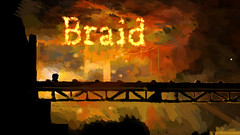
Jon: It was nice to have a solid, well-defined platform to focus on while finishing the actual game part of the game, before having to worry about all the programming involved in dealing with PC compatibility issues. So I think the game benefited some from my being able to focus on a single tangible experience that the user would have.
Leigh: Braid feels like a game you want people to become emotionally engaged in more than just played, do you feel its important for games to be more than a test of skill or memory?
Jon: I wouldn’t ever claim that all games should be a certain way. There are a lot of possibilities for where games can go, and it’s probably a good idea to explore them all.
Leigh: Is it better to elicit emotional responses through gameplay or narrative? Does it matter if either is well done?
Jon: I gave a whole lecture recently about why I think story-based games have a lot of problems. Here’s the link: http://braid-game.com/news/?p=385 . If a designer is thinking about making something emotional through narrative, I would encourage some kind of narrative structure that is not trying to be a conventional linear story. Of course the gameplay route is also full of untapped potential, but there are reasons why it can be difficult to make headway there, which I discuss in the lecture.
Leigh: You spend a lot of time making prototypes of different gameplay mechanics, is it as much about implementation as innovation?
Jon: If you mean about enjoying the craft of programming… I have to admit I don’t really enjoy programming very much any more, because in order to get things done I have adopted a style of programming that makes it as simple as I can, so that it is just easy to get things done, and it only requires time and a lot of typing. So I am not really solving any difficult puzzles or challenges when programming, as beginning programmers might. On the plus side, this means I can program in a relatively efficient manner; on the minus side, it’s a less-engaging activity. I make up for that on the design side; whether I am making a prototype or a full game, it’s about exploring some interesting space of ideas. Programming is now just the implementation detail of how I do that exploration.
It’s not really about innovation so much as exploring interestingness. There is this idea of chasing innovation in game design that I used to be a big proponent of, but that I now suspect is a little bit misdirected.
Leigh: You’re not afraid to throw away cool ideas when they don’t feel right at the prototype stage. A lot of other developers might not be so detached from their ideas.
Jon: These things are true! I try to encourage people to be willing to delete stuff that is mediocre or just kind of good – or at least put that stuff in a closet for some future day – so that they can focus on the stuff that is great. Many people don’t think that way, though. When it is so hard to get anything substantial done, you just don’t want to throw away any of your hard-earned progress. One solution is to make it easier to make progress.
Leigh: Should all games try to innovate? Is re-interpreting the implementation of an innovative new mechanic as valid? I ask because it’s worth noting a number of games have time-play in them now.
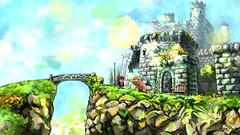
Jon: I think gameplay innovation can result in things that are interesting, but at the same time it doesn’t automatically result in something that is deep — often it’s a gimmick. I am interested in deepness and richness of game design. You can get that with deliberate innovation or without; I think the issues are orthogonal. At the same time, I think if a designer is working on something he really cares about, and is really exploring some ideas in his own style, bringing his own particular insight to the table, then he will automatically come up with something different than most other games; furthermore, this will be a deeper, more-compelling kind of innovation.
That’s what I meant earlier about the deliberate chasing of innovation being a somewhat misguided pursuit. Yes, you can make neat stuff that way, but the innovation will come to you for free if you do things a different way, and you are likely to end up with a different result.
To take a specific example, Braid would be kind of interesting if it were a game with gimmicky time-manipulation mechanics, but I think that many players find it more interesting than that because it is built on a core philosophy and a thorough exploration of a certain set of ideas. Players can feel that, even if they can’t say what the philosophy is or explain the ideas being explored.
Leigh: With talk of innovation and emotional investment, there are still some very conventional design choices like jumping on the head of monsters, moving platforms, ladders, levers and collectables. Is this saying fundamentally there’s not so much wrong with games as they are, they just missing those one or two extra ideas to make them more worthwhile?
Jon: I did these things because they were right for Braid; for another game, I would do something completely different. I don’t think you should take the presence of these elements in Braid as any kind of statement about whether anything is or isn’t wrong with games as they are.
Leigh: Can you talk a little about what inspires your design choices?
Jon: I’d like to, but this is a very broad question. Hopefully in the previous answers I have at least given a little bit of information about this.
Leigh: What about games that you enjoy, are there any real favourites you can say have had an impact on you in some way?
Jon: There are a lot of games that I’ve played that I enjoyed and that influenced the design of Braid. Probably too many to name. Games that currently spring to mind as “favorites” are very different and probably didn’t influence Braid too much (examples: Netrek, and Counter-Strike sometime around the beta 4 – beta 5 timeframe).
Leigh: Since Braid is a platformer, I want to tell you my favourite platformer of all time was The New Zealand Story. Any chance of a remake with time reversal? :)
Jon: I never played The New Zealand Story! Maybe I’ll be able to check it out sometime.
Leigh: Heh, I was only joking, but have you ever wanted to remake any old favorites, felt there was an opportunity missed that you’d like to explore?
Jon: I often get the idea to remake old games, though I usually don’t do it. Actually, though, one of the earlier ideas I was playing with in Braid was that there would be secret levels with remakes of classic games, modified with the time rules of each particular world, accessible when you finished each puzzle. I had an entire remake of Mountain King in Braid at one point. I think it was better than the original Mountain King, with more-sophisticated gameplay, but it didn’t fit what Braid was becoming, so I eventually took it out.
Leigh: Thanks for your time Jon! It’s been really great to hear from you.
Jon: You’re welcome!
Jonathan Blow created Braid for the Xbox 360 and PC which is available now at various digital outlets. You can view the Braid website, Jon has a blog and he is also a workshop organizer at The Experimental Gameplay Workshop
To top it all off, he’s an indie superhero who could talk the hind legs off a donkey, bravo sir!
Runner
By: Xander
On: April 20th, 2009
Runner is a freeware game released today, made by three Destructoid Staff Members. Ashley Davis and Johnathan Holmes created the artwork, whilst overall design and programming was handled by Anthony Burch, who as I’ve mentioned before is a major supporter of the Indie Games scene and provided a lot of coverage during GDC.
Runner is a short game, roughly the length of Judith which we’ve covered previously. The controls are simple (Arrows move. Space jumps. The classics.), though it’s suprisingly challenging given the distractions that appear to impede your progress. Also like Judith it’s certainly more balanced towards thematic concerns and aesthetics than gameplay. That said anyone who was annoyed by the lack of ‘interactivity’ in Judith will be a little more satisfied with this as challenge, and indeed failure, are present. Again though, saying anything further is in danger of spoiling things. So play, think. and we’ll discuss in the comments/extended!
(Minor Edit: It apparently takes a little while to load, incase it looks like it’s either frozen or isn’t loading.)
Dwarf Fortress: Life Imitates Art
By: Derek Yu
On: April 16th, 2009
Happy belated birthday, Tarn. Congratulations on the new kitten… gulp!
I’m going to get flamed for posting this, aren’t I?
IGS ’09: Beyond Single-Player (Jason Rohrer)
By: Brandon McCartin (BMcC)
On: March 24th, 2009
Jason Rohrer’s lecture for the Independent Games Summit this year (2009) was both surprising and painfully obvious.
IGS ’09: The Four-Hour Game Design (Cactus)
By: Brandon McCartin (BMcC)
On: March 23rd, 2009

Jonatan “Cactus” Söderström’s lecture for the 2009 Independent Games Summit, The Four-Hour Game Design, opened up his bizarre creative process, revealing some of the design guidelines and key tricks that have allowed him to make more (awesome) games per day than the rest of the industry combined manages to put out in a year.
It may have been the greatest presentation ever.
Starting from his Desktop, Cactus skipped over a few folders called things like “Weird Porn” and “Nude Pictures of Me” to one simply named “GDC.” Within, bearing the icon of a pixelated heart, was his presentation… made in Game Maker.
After registering Windows Media Player live on stage to test the audio, and eventually realizing he had to un-mute his laptop, Cactus started it up. A Brain-Damaged Toon Underworld style animation began with a character only he could have drawn declaring, “I AM INTERNET.”

I ripped some (TIGSOURCE EXCLUSIVE) screens from Cactus’ laptop while he was asleep, but there will eventually be a video of all the “slides,” or perhaps even a download of the presentation/game itself, so I won’t spoil too much of it now. Here’s a brief summary, in the extended:
Don’t Make Games In Four Hours If You Stink

In the first section of the presentation, “WHY,” Cactus likened game development to “having a baby,” then proceeded to drive that metaphor well past the line of any decency, with upsetting photos to boot.
Highlight: The hardest part is “getting it out”—it’s painful and the end result is often not what you expected. (But at least you learn from it.)
When You Make A Game, Try To Make A Good One
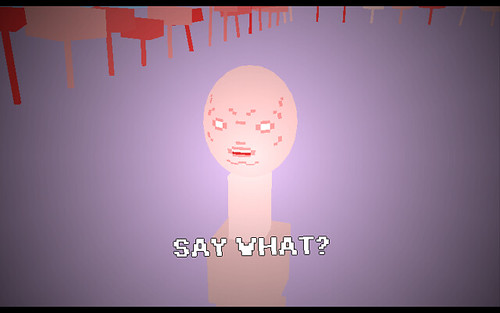
The main points of the second section, “CREATIVITY,” were: Always experiment, be serious about what you’re doing, renew your concepts, don’t think the game needs to be fun (it could be “interesting or weird or just freak you out”), and try to create a cohesive experience.
For times when you’re not feeling creative, Cactus recommended mimicking another game, but challenging its original concept, trying to do things better in some way. (This bit was supplemented by a trippy 3D scene of dialog between two polygonal characters, which I now know had randomized camera angles.)
Try To Be Original When You Make An Original Game
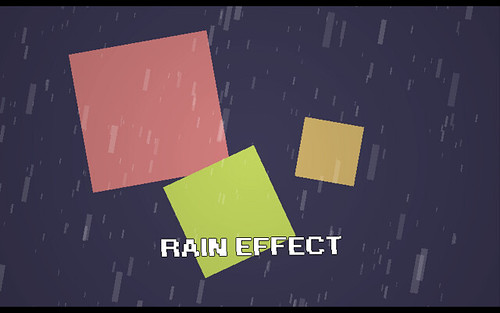
In the third section, “GRAPHICS,” Cactus outlined a number of simple ways to use your game’s tech to multiply the effectiveness of basic, easy-to-produce art assets (such as sketches, pixel art, geometric shapes, and so on). He then gave many strange examples of using color & saturation, rotation, scaling, basic animation, flicker, movement, atmosphere (“RAIN EFFECT”), and other quick tricks to make the visuals considerably more interesting without too much extra work.
Sometimes Games Don’t Have To Be Fun
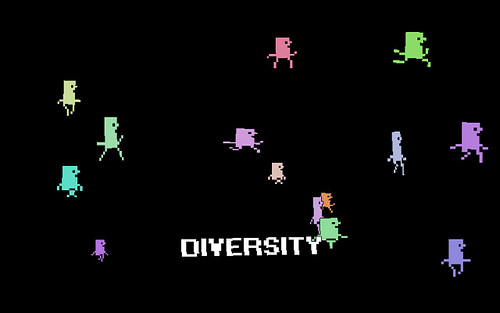
In the fourth section of the presentation, “GAMEPLAY,” Cactus asked the age old question: “Who wants to jump on an enemy that many times?”
He then went on to show a few minor gameplay changes in different situations that have a huge impact on the feel of the game. For example, he played a potential horizontal shmup where you must shoot incoming square “asteroids” a bunch of times to destroy them. A bit later he played an updated version that was faster, with less hits required to destroy each asteroid, and a quick explosion effect that made the game clearly more awesome. Unfortunately, he lost pretty quickly when playing this, so he had to move on.
Don’t Work Too Hard, You’ll Get Tired
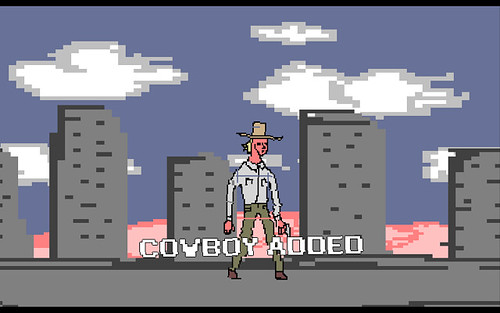
In the fifth section, “PREPARATIONS,” Cactus gave some health advice, pointing out the critical importance of going to the bathroom, eating (but not too much, unless you want to end up in the bathroom again), having an idea ready before you start, using the right tools, and taking every shortcut possible.
If you work cleverly and take care of yourself, you won’t need to work as aggressively, either, and the game will become less of a headache to pull together.
Games Made Of Rock Don’t Always Rock
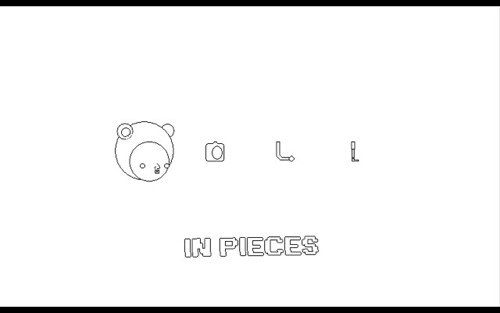
In the final section of the lecture, Cactus pointed people toward TIGForum member Dr. Petter’s excellent SFXR, which he’s been using for pretty much every project nowadays, and recommended collaboration with online musicians eager to compose. (That, or stealing their music. But if your game wins an award or something, “it might be a good idea to email” them about it.)
A final tip was displayed, “Some Games Have Good Music,” and the slideshow abruptly ended. The audience sat in silence for moment wondering if there was going to be another curve ball, but once it was understood that the thing was actually over, the room erupted into applause.
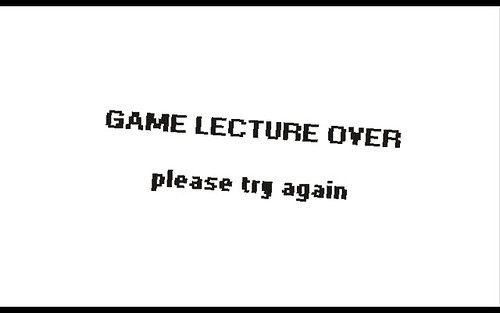
Now, to a game developer, the direct content of this presentation didn’t give that much new information, but, at least for me and everyone else I talked to, as a whole it was incredibly inspiring and enlightening. I imagine a number of developers well aware of these techniques may not have thought to really use them like this. And if anyone in the room hadn’t heard of Cactus before, this must have been a knockout. It was just as free-form, exciting, and sometimes confounding as a Cactus game, and surely one of the most interactive, unpredictable talks GDC has ever seen.
Even giving a lecture, Jonatan can’t help being Cactus.
P.S. He made, like, forty more games while he was speaking.
